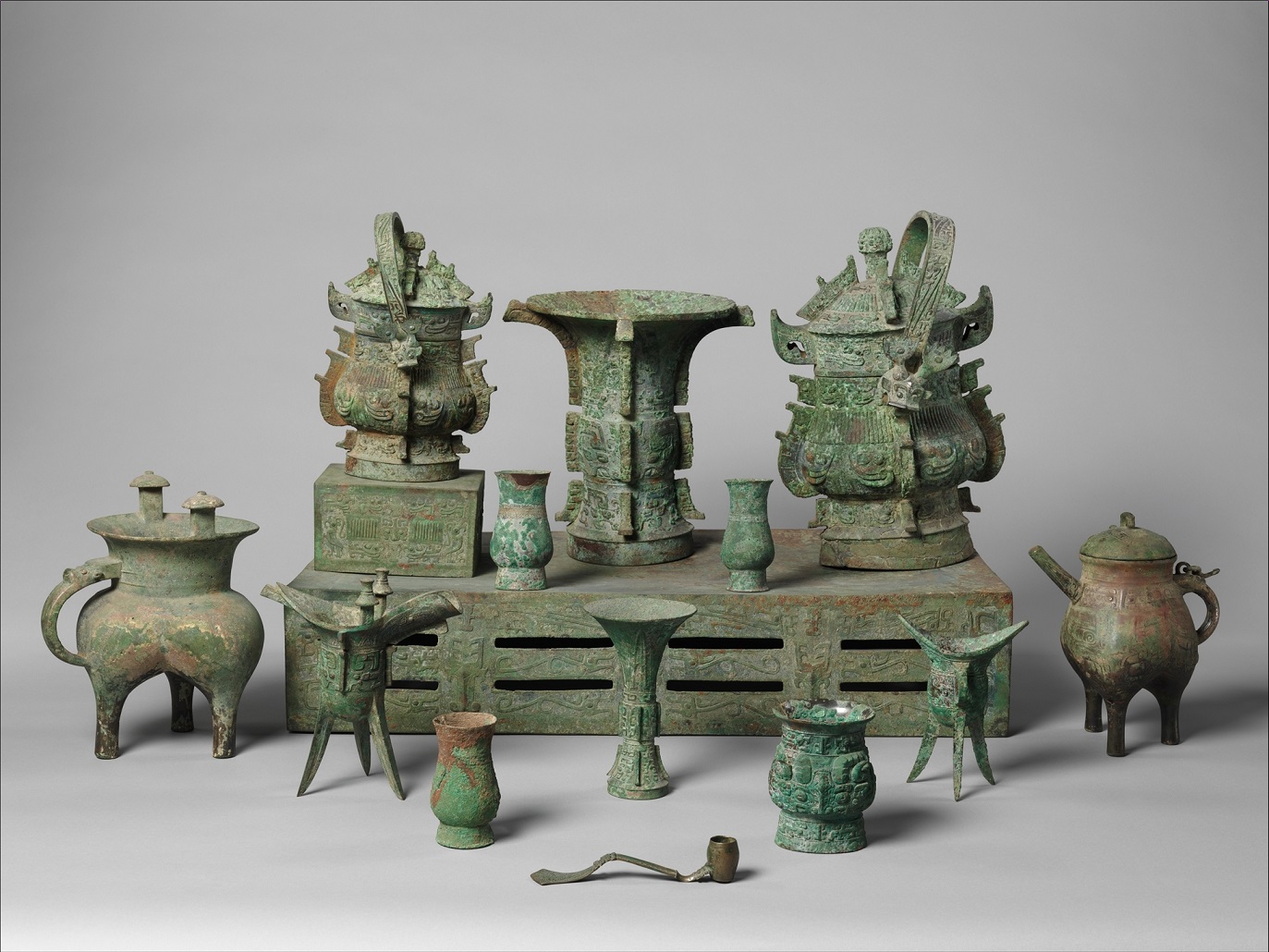
By Department of Asian Art
The Metropolitan Museum of Art
The long period of the Bronze Age in China, which began around 2000 B.C., saw the growth and maturity of a civilization that would be sustained in its essential aspects for another 2,000 years. In the early stages of this development, the process of urbanization went hand in hand with the establishment of a social order. In China, as in other societies, the mechanism that generated social cohesion, and at a later stage statecraft, was ritualization. As most of the paraphernalia for early rituals were made in bronze, and as rituals carried such an important social function, it is perhaps possible to read into the forms and decorations of these objects some of the central concerns of the societies (at least the upper sectors of the societies) that produced them.
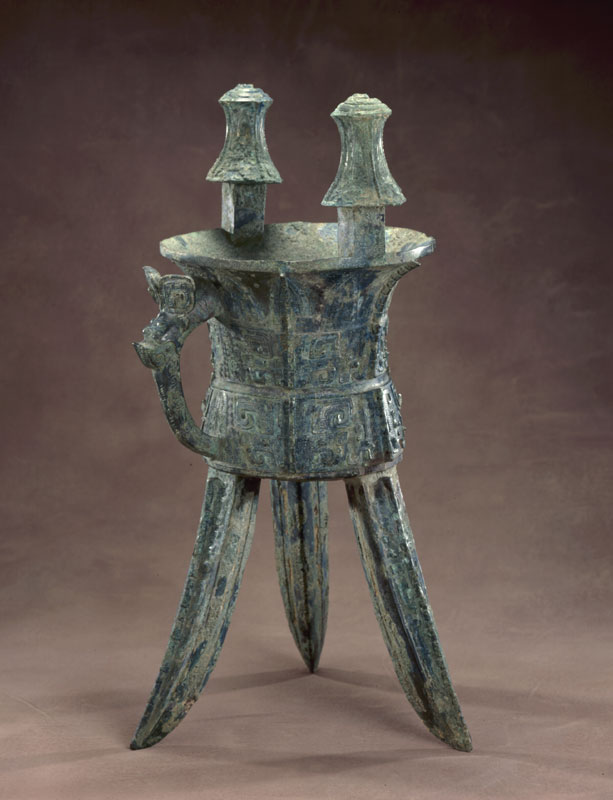
There were probably a number of early centers of bronze technology, but the area along the Yellow River in present-day Henan Province emerged as the center of the most advanced and literate cultures of the time and became the seat of the political and military power of the Shang dynasty (ca. 1600–1046 B.C.), the earliest archaeologically recorded dynasty in Chinese history. The Shang dynasty was conquered by the people of Zhou, who came from farther up the Yellow River in the area of Xi’an in Shaanxi Province. In the first years of the Zhou dynasty (1046–256 B.C.), known as the Western Zhou (1046–771 B.C.), the ruling house of Zhou exercised a certain degree of “imperial” power over most of central China. With the move of the capital to Luoyang in 770 B.C., however, the power of the Zhou rulers declined and the country divided into a number of nearly autonomous feudal states with nominal allegiance to the emperor. The second phase of the Zhou dynasty, known as the Eastern Zhou (770–256 B.C.), is subdivided into two periods, the Spring and Autumn period (770–ca. 476 B.C.) and the Warring States period (475–221 B.C.). During the Warring States period, seven major states contended for supreme control of the country, ending with the unification of China under the Qin in 221 B.C.
Although there is uncertainty as to when metallurgy began in China, there is reason to believe that early bronzeworking developed autonomously, independent of outside influences. The era of the Shang and the Zhou dynasties is generally known as the Bronze Age of China, because bronze, an alloy of copper and tin, used to fashion weapons, parts of chariots, and ritual vessels, played an important role in the material culture of the time. Iron appeared in China toward the end of the period, during the Eastern Zhou dynasty.
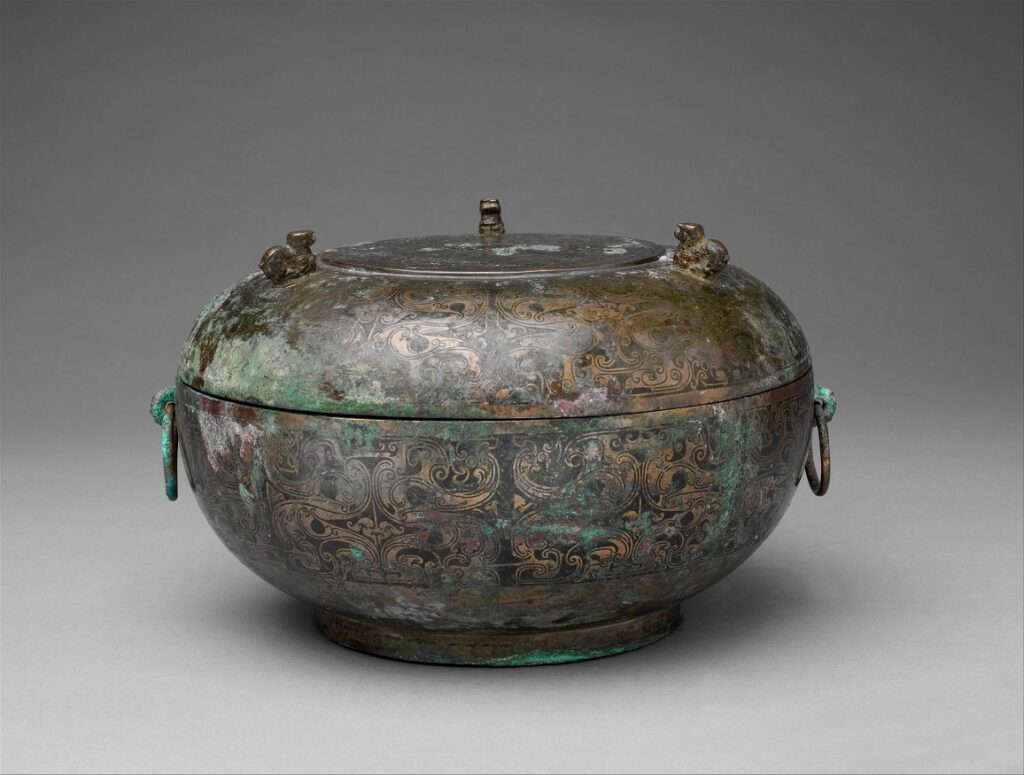
The earliest Chinese bronzes were made by the method known as piece-mold casting—as opposed to the lost-wax method, which was used in all other Bronze Age cultures. In piece-mold casting, a model is made of the object to be cast, and a clay mold taken of the model. The mold is then cut in sections to release the model, and the sections are reassembled after firing to form the mold for casting. If the object to be cast is a vessel, a core has to be placed inside the mold to provide the vessel’s cavity. The piece-mold method was most likely the only one used in China until at least the end of the Shang dynasty. An advantage of this rather cumbersome way of casting bronze was that the decorative patterns could be carved or stamped directly on the inner surface of the mold before it was fired. This technique enabled the bronzeworker to achieve a high degree of sharpness and definition in even the most intricate designs.
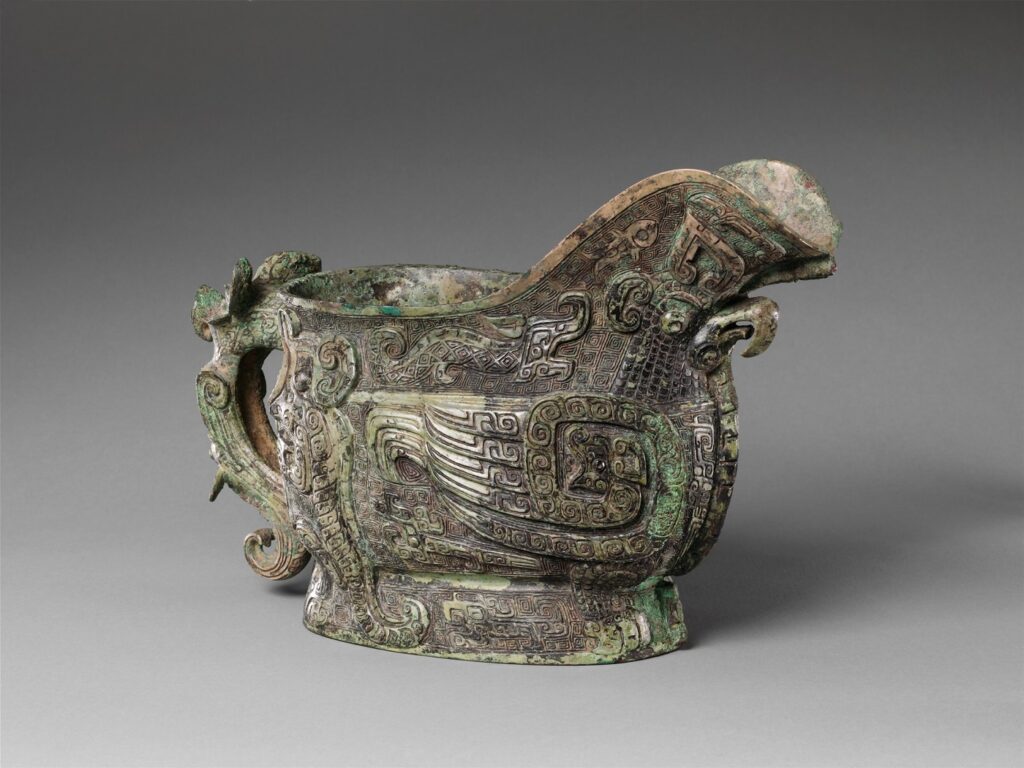
One of the most distinctive and characteristic images decorating Shang-dynasty bronze vessels is the so-called taotie. The primary attribute of this frontal animal-like mask is a prominent pair of eyes, often protruding in high relief. Between the eyes is a nose, often with nostrils at the base. Taotie can also include jaws and fangs, horns, ears, and eyebrows. Many versions include a split animal-like body with legs and tail, each flank shown in profile on either side of the mask. While following a general form, the appearance and specific components of taotie masks varied by period and place of production. Other common motifs for Shang ritual bronze vessels were dragons, birds, bovine creatures, and a variety of geometric patterns. Currently, the significance of the taotie, as well as the other decorative motifs, in Shang society is unknown.
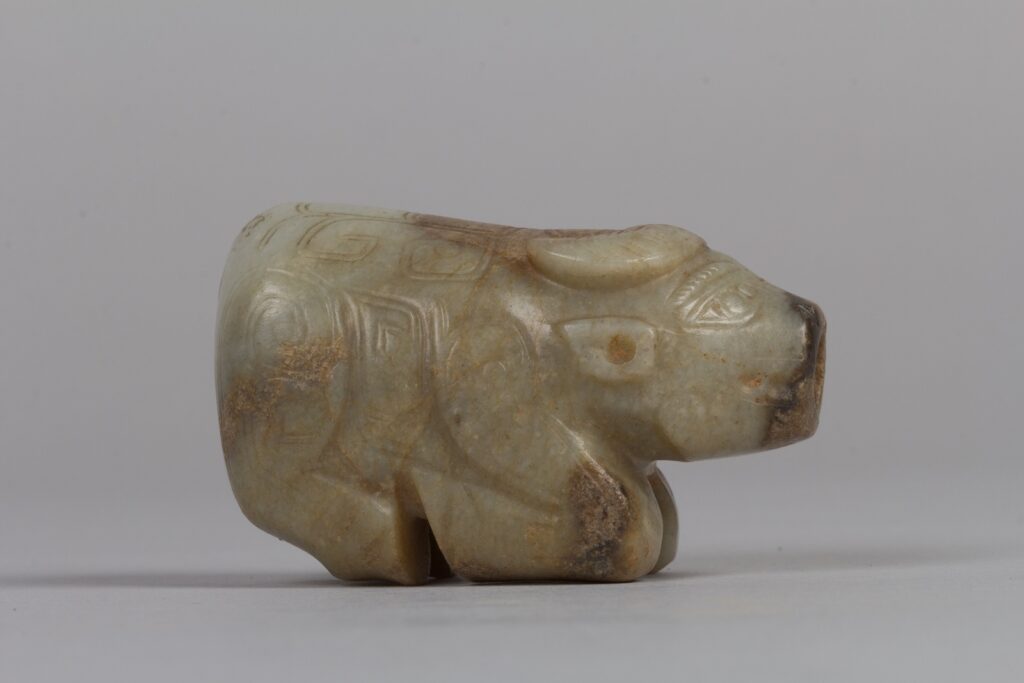
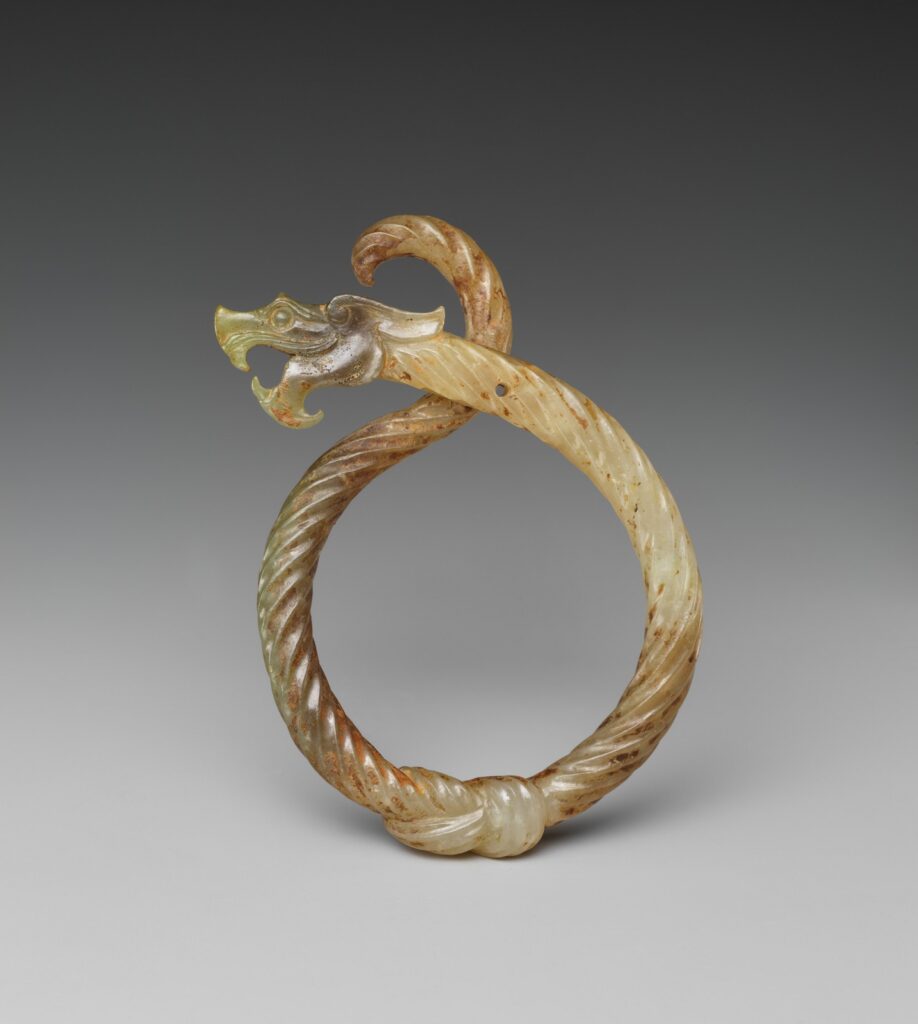
Jade, along with bronze, represents the highest achievement of Bronze Age material culture. In many respects, the Shang dynasty can be regarded as the culmination of 2,000 years of the art of jade carving. Shang craftsmen had full command of the artistic and technical language developed in the diverse late Neolithic cultures that had a jade-working tradition. On the other hand, some developments in Shang and Zhou jade carving can be regarded as evidence of decline. While Bronze Age jade workers no doubt had better tools—if only the advantage of metal ones—the great patience and skill of the earlier period seem to be lacking.
If the precise function of ritual jades in the late Neolithic is indeterminate, such is not the case in the Bronze Age. Written records and archaeological evidence inform us that jades were used in sacrificial offerings to gods and ancestors, in burial rites, for recording treaties between states, and in formal ceremonies at the courts of kings.
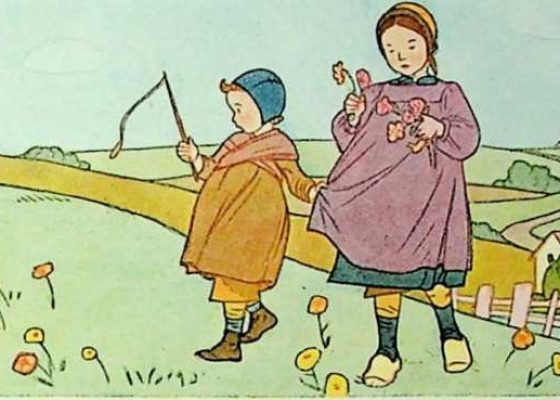





Cancel anytime


Using our website
You may use the The Middle Land website subject to the Terms and Conditions set out on this page. Visit this page regularly to check the latest Terms and Conditions. Access and use of this site constitutes your acceptance of the Terms and Conditions in-force at the time of use.
Intellectual property
Names, images and logos displayed on this site that identify The Middle Land are the intellectual property of New San Cai Inc. Copying any of this material is not permitted without prior written approval from the owner of the relevant intellectual property rights.
Requests for such approval should be directed to the competition committee.
Please provide details of your intended use of the relevant material and include your contact details including name, address, telephone number, fax number and email.
Linking policy
You do not have to ask permission to link directly to pages hosted on this website. However, we do not permit our pages to be loaded directly into frames on your website. Our pages must load into the user’s entire window.
The Middle Land is not responsible for the contents or reliability of any site to which it is hyperlinked and does not necessarily endorse the views expressed within them. Linking to or from this site should not be taken as endorsement of any kind. We cannot guarantee that these links will work all the time and have no control over the availability of the linked pages.
Submissions
All information, data, text, graphics or any other materials whatsoever uploaded or transmitted by you is your sole responsibility. This means that you are entirely responsible for all content you upload, post, email or otherwise transmit to the The Middle Land website.
Virus protection
We make every effort to check and test material at all stages of production. It is always recommended to run an anti-virus program on all material downloaded from the Internet. We cannot accept any responsibility for any loss, disruption or damage to your data or computer system, which may occur while using material derived from this website.
Disclaimer
The website is provided ‘as is’, without any representation or endorsement made, and without warranty of any kind whether express or implied.
Your use of any information or materials on this website is entirely at your own risk, for which we shall not be liable. It is your responsibility to ensure any products, services or information available through this website meet your specific requirements.
We do not warrant the operation of this site will be uninterrupted or error free, that defects will be corrected, or that this site or the server that makes it available are free of viruses or represent the full functionality, accuracy and reliability of the materials. In no event will we be liable for any loss or damage including, without limitation, loss of profits, indirect or consequential loss or damage, or any loss or damages whatsoever arising from the use, or loss of data, arising out of – or in connection with – the use of this website.
Last Updated: October 1, 2023
New San Cai Inc. (hereinafter “The Middle Land,” “we,” “us,” or “our”) owns and operates www.themiddleland.com, its affiliated websites and applications (our “Sites”), and provides related products, services, newsletters, and other offerings (together with the Sites, our “Services”) to art lovers and visitors around the world.
This Privacy Policy (the “Policy”) is intended to provide you with information on how we collect, use, and share your personal data. We process personal data from visitors of our Sites, users of our Services, readers or bloggers (collectively, “you” or “your”). Personal data is any information about you. This Policy also describes your choices regarding use, access, and correction of your personal information.
If after reading this Policy you have additional questions or would like further information, please contact us.
PERSONAL DATA WE COLLECT AND HOW WE USE IT
We collect and process personal data only for lawful reasons, such as our legitimate business interests, your consent, or to fulfill our legal or contractual obligations.
Information You Provide to Us
Most of the information Join Talents collects is provided by you voluntarily while using our Services. We do not request highly sensitive data, such as health or medical information, racial or ethnic origin, political opinions, religious or philosophical beliefs, trade union membership, etc. and we ask that you refrain from sending us any such information.
Here are the types of personal data that you voluntarily provide to us:
As a registered users or customers, you may ask us to review or retrieve emails sent to your business. We will access these emails to provide these services for you.
We use the personal data you provide to us for the following business purposes:
Information Obtained from Third-Party Sources
We collect and publish biographical and other information about users, which we use to promote the articles and our bloggers who use our sites. If you provide personal information about others, or if others give us your information, we will only use that information for the specific reason for which it was provided.
Information We Collect by Automated Means
Log Files
The site uses your IP address to help diagnose server problems, and to administer our website. We use your IP addresses to analyze trends and gather broad demographic information for aggregate use.
Every time you access our Site, some data is temporarily stored and processed in a log file, such as your IP addresses, the browser types, the operating systems, the recalled page, or the date and time of the recall. This data is only evaluated for statistical purposes, such as to help us diagnose problems with our servers, to administer our sites, or to improve our Services.
Do Not Track
Your browser or device may include “Do Not Track” functionality. Our information collection and disclosure practices, and the choices that we provide to customers, will continue to operate as described in this Privacy Policy, whether or not a “Do Not Track” signal is received.
HOW WE SHARE YOUR INFORMATION
We may share your personal data with third parties only in the ways that are described in this Privacy Policy. We do not sell, rent, or lease your personal data to third parties, and We does not transfer your personal data to third parties for their direct marketing purposes.
We may share your personal data with third parties as follows:
There may be other instances where we share your personal data with third parties based on your consent.
HOW WE STORE AND SECURE YOUR INFORMATION
We retain your information for as long as your account is active or as needed to provide you Services. If you wish to cancel your account or request that we no longer use your personal data, contact us. We will retain and use your personal data as necessary to comply with legal obligations, resolve disputes, and enforce our agreements.
All you and our data are stored in the server in the United States, we do not sales or transfer your personal data to the third party. All information you provide is stored on a secure server, and we generally accepted industry standards to protect the personal data we process both during transmission and once received.
YOUR RIGHTS/OPT OUT
You may correct, update, amend, delete/remove, or deactivate your account and personal data by making the change on your Blog on www.themiddleland.com or by emailing our customer service. We will respond to your request within a reasonable timeframe.
You may choose to stop receiving Join Talents newsletters or marketing emails at any time by following the unsubscribe instructions included in those communications, or you can contact us.
LINKS TO OTHER WEBSITES
The Middle Land include links to other websites whose privacy practices may differ from that of ours. If you submit personal data to any of those sites, your information is governed by their privacy statements. We encourage you to carefully read the Privacy Policy of any website you visit.
NOTE TO PARENTS OR GUARDIANS
Our Services are not intended for use by children, and we do not knowingly or intentionally solicit data from or market to children under the age of 18. We reserve the right to delete the child’s information and the child’s registration on the Sites.
PRIVACY POLICY CHANGES
We may update this Privacy Policy to reflect changes to our personal data processing practices. If any material changes are made, we will notify you on the Sites prior to the change becoming effective. You are encouraged to periodically review this Policy.
HOW TO CONTACT US
If you have any questions about our Privacy Policy, please contact customer service or send us mail at:
The Middle Land/New San Cai
100 Wilshire Blvd., 7th Floor
Santa Monica, CA 90401
USA
The Michelin brothers created the guide, which included information like maps, car mechanics listings, hotels and petrol stations across France to spur demand.
The guide began to award stars to fine dining restaurants in 1926.
At first, they offered just one star, the concept was expanded in 1931 to include one, two and three stars. One star establishments represent a “very good restaurant in its category”. Two honour “excellent cooking, worth a detour” and three reward “exceptional cuisine, worth a
Thank you for your participation,
please Log in or Sign up to Vote

123Sign in to your account
Exploring the Current Spate of UFO Sightings: Why Are We Still Discussing UFOs and Their Phenomena?